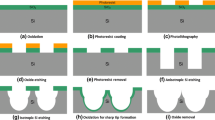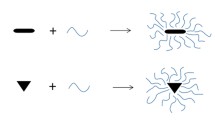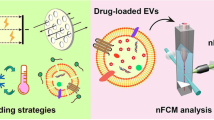Abstract
Purpose
To investigate the cellular internalization pathways of shape- and size-specific particles as a function of zeta potential in different cell types.
Methods
A top-down particle fabrication technique called PRINT was utilized to fabricate monodisperse 1 μm cylindrical particles. Cellular internalization of these PRINT particles was monitored using confocal microscopy, flow cytometry, and transmission electron microscopy. The endocytic pathway used by 1 μm cationic PRINT particles was evaluated using different inhibitory strategies. Cytotoxicity assays were used to determine the toxicity of both cationic and anionic PRINT particles in multiple cell types.
Results
Particle internalization was confirmed using confocal microscopy, flow cytometry and transmission electron microscopy. The mechanism of internalization of positively charged PRINT particles was found to be predominantly clathrin-mediated endocytosis and macropinocytosis with very few particles utilizing a caveolae-mediated endocytic pathway. The exposed charge on the surface of the particles had a significant effect on the rate of endocytosis in all cell types tested, except for the macrophage cells. No significant cytotoxicity was observed for all PRINT particles used in the present study.
Conclusions
Cylindrical 1 μm PRINT particles were readily internalized into HeLa, NIH 3T3, OVCAR-3, MCF-7, and RAW 264.7 cells. Particles with a positive zeta potential exhibited an enhanced rate of endocytosis compared to negatively charged particles with identical sizes and shapes. It was found that PRINT particles with a positive zeta potential were endocytosed into HeLa cells using predominantely clathrin-mediated and macropinocytotic pathways.






Similar content being viewed by others
References
A. D’Emanueleand, and D. Attwood. Dendrimer-drug interactions. Adv. Drug Deliv. Rev. 57:2147–2162 (2005) doi:10.1016/j.addr.2005.09.012.
N. C. Bellocq, D. W. Kang, X. H. Wang, G. S. Jensen, S. H. Pun, T. Schluep, M. L. Zepeda, and M. E. Davis. Synthetic biocompatible cyclodextrin-based constructs for local gene delivery to improve cutaneous wound healing. Bioconjug. Chem. 15:1201–1211 (2004) doi:10.1021/bc0498119.
M. A. Wolfert, P. R. Dash, O. Nazarova, D. Oupicky, L. W. Seymour, S. Smart, J. Strohalm, and K. Ulbrich. Polyelectrolyte vectors for gene delivery: Influence of cationic polymer on biophysical properties of complexes formed with DNA. Bioconjug. Chem. 10:993–1004 (1999) doi:10.1021/bc990025r.
S. M. Moghimi, A. C. Hunter, and J. C. Murray. Nanomedicine: current status and future prospects. FASEB J. 19:311–330 (2005) doi:10.1096/fj.04-2747rev.
Y. Barenholz. Liposome application: problems and prospects. Curr. Opin. Colloid Interface Sci. 6:66–77 (2001) doi:10.1016/S1359-0294(00)00090-X.
R. Duncan. The dawning era of polymer therapeutics. Nature Reviews Drug Discovery. 2:347–360 (2003) doi:10.1038/nrd1088.
G. S. Kwonand, and K. Kataoka. Block-Copolymer Micelles as Long-Circulating Drug Vehicles. Adv. Drug Deliv. Rev. 16:295–309 (1995) doi:10.1016/0169-409X(95)00031-2.
C. C. Lee, J. A. MacKay, J. M. J. Frechet, and F. C. Szoka. Designing dendrimers for biological applications. Nat. Biotechnol. 23:1517–1526 (2005) doi:10.1038/nbt1171.
K. McAllister, P. Sazani, M. Adam, M. J. Cho, M. Rubinstein, R. J. Samulski, and J. M. DeSimone. Polymeric nanogels produced via inverse microemulsion polymerization as potential gene and antisense delivery agents. J. Am. Chem. Soc. 124:15198–15207 (2002) doi:10.1021/ja027759q.
V. P. Torchilin. Targeted polymeric micelles for delivery of poorly soluble drugs. Cell. Mol. Life Sci. 61:2549–2559 (2004) doi:10.1007/s00018-004-4153-5.
M. J. Vicentand, and R. Duncan. Polymer conjugates: nanosized medicines for treating cancer. Trends Biotech. 24:39–47 (2006) doi:10.1016/j.tibtech.2005.11.006.
H. P. Zobel, F. Stieneker, S. A. A. Aziz, M. Gilbert, D. Werner, C. R. Noe, J. Kreuter, and A. Zimmer. Evaluation of aminoalkylmethacrylate nanoparticles as colloidal drug carrier systems. Part II: characterization of antisense oligonucleotides loaded copolymer nanoparticles. Eur. J. Pharm. Biopharm. 48:1–12 (1999) doi:10.1016/S0939-6411(99)00003-X.
H. P. Zobel, A. Zimmer, S. A. A. Aziz, M. Gilbert, D. Werner, C. R. Noe, J. Kreuter, and F. Stieneker. Evaluation of aminoalkylmethacrylate nanoparticles as colloidal drug carrier systems. Part I: synthesis of monomers, dependence of the physical properties on the polymerization methods. Eur. J. Pharm. Biopharm. 47:203–213 (1999) doi:10.1016/S0939-6411(98)00100-3.
R. Langer. Drug delivery and targeting. Nature. 392:5–10 (1998).
R. P. Kulkarni, D. D. Wu, M. E. Davis, and S. E. Fraser. Quantitating intracellular transport of polyplexes by spatio-temporal image correlation spectroscopy. Proc. Natl. Acad. Sci. U. S. A. 102:7523–7528 (2005) doi:10.1073/pnas.0501950102.
N. C. Bellocq, S. H. Pun, G. S. Jensen, and M. E. Davis. Transferrin-containing, cyclodextrin polymer-based particles for tumor-targeted gene delivery. Bioconjug. Chem. 14:1122–1132 (2003) doi:10.1021/bc034125f.
S. Svensonand, and D. A. Tomalia. Commentary - Dendrimers in biomedical applications - reflections on the field. Adv. Drug Deliv. Rev. 57:2106–2129 (2005) doi:10.1016/j.addr.2005.09.018.
R. Duncanand, and L. Izzo. Dendrimer biocompatibility and toxicity. Adv. Drug Deliv. Rev. 57:2215–2237 (2005) doi:10.1016/j.addr.2005.09.019.
G. Domokos, B. Jopski, and K. H. Schmidt. Preparation, Properties and Biological Function of Liposome Encapsulated Hemoglobin. Biomater. Artif. Cells Immobil. Biotechnol. 20:345–354 (1992).
G. S. Kwonand, and K. Kataoka. Block-Copolymer Micelles as Long-Circulating Drug Vehicles. Adv. Drug Deliv. Rev. 16:295–309 (1995) doi:10.1016/0169-409X(95)00031-2.
J. A. Champion, Y. K. Katare, and S. Mitragotri. Particle shape: A new design parameter for micro- and nanoscale drug delivery carriers. J. Control. Release. 121:3–9 (2007) doi:10.1016/j.jconrel.2007.03.022.
L. E. Euliss, J. A. DuPont, S. Gratton, and J. DeSimone. Imparting size, shape, and composition control of materials for nanomedicine. Chem. Soc. Rev. 35:1095–1104 (2006) doi:10.1039/b600913c.
D. R. Arifinand, and A. F. Palmer. Stability of liposome encapsulated hemoglobin dispersions. Artificial Cells Blood Substitutes and Biotechnology. 33:113–136 (2005) doi:10.1081/BIO-200055874.
S. L. Li, B. Byrne, J. Welsh, and A. F. Palmer. Self-assembled poly(butadiene)-b-poly(ethylene oxide) polymersomes as paclitaxel carriers. Biotechnol. Prog. 23:278–285 (2007) doi:10.1021/bp060208+.
S. E. A. Gratton, P. D. Pohlhaus, J. Lee, J. Guo, M. J. Cho, and J. M. DeSimone. Nanofabricated particles for engineered drug therapies: A preliminary biodistribution study of PRINT (TM) nanoparticles. J. Control. Release. 121:10–18 (2007) doi:10.1016/j.jconrel.2007.05.027.
J. P. Rolland, B. W. Maynor, L. E. Euliss, A. E. Exner, G. M. Denison, and J. M. DeSimone. Direct fabrication and harvesting of monodisperse, shape-specific nanobiomaterials. J. Am. Chem. Soc. 127:10096–10100 (2005) doi:10.1021/ja051977c.
A. Fattorossi, R. Nisini, J. G. Pizzolo, and R. Damelio. New, Simple Flow-Cytometry Technique to Discriminate between Internalized and Membrane-Bound Particles in Phagocytosis. Cytometry. 10:320–325 (1989) doi:10.1002/cyto.990100311.
R. M. Martin, H. Leonhardt, and M. C. Cardoso. DNA labeling in living cells. Cytometry Part A. 67A:45–52 (2005) doi:10.1002/cyto.a.20172.
B. L. Clarkeand, and P. H. Weigel. Recycling of the Asialoglycoprotein Receptor in Isolated Rat Hepatocytes - Atp Depletion Blocks Receptor Recycling but Not a Single Round of Endocytosis. J. Biol. Chem. 260:128–133 (1985).
E. Macia, M. Ehrlich, R. Massol, E. Boucrot, C. Brunner, and T. Kirchhausen. Dynasore, a cell-permeable inhibitor of dynamin. Developmental Cell. 10:839–850 (2006) doi:10.1016/j.devcel.2006.04.002.
O. Harush-Frenkel, N. Debotton, S. Benita, and Y. Altschuler. Targeting of nanoparticles to the clathrin-mediated endocytic pathway. Biochem. Biophys. Res. Commun. 353:26–32 (2007) doi:10.1016/j.bbrc.2006.11.135.
M. C. Garnett. Gene-delivery systems using cationic polymers. Crit. Rev. Ther. Drug Carr. Syst. 16:147–207 (1999).
W. Zauner, M. Ogris, and E. Wagner. Polylysine-based transfection systems utilizing receptor-mediated delivery. Adv. Drug Deliv. Rev. 30:97–113 (1998) doi:10.1016/S0169-409X(97)00110-5.
Acknowledgements
This work was supported in part by the STC Program of the NSF (CHE-9876674), NIH PPG P01-GM059299-07, NIH 5-654-CA119343-02 (the Carolina Center of Cancer Nanotechnology Excellence), the William R. Kenan Professorship of the University of North Carolina at Chapel Hill, and Liquidia Technologies (SRA 04-0013).
Author information
Authors and Affiliations
Corresponding author
Rights and permissions
About this article
Cite this article
Gratton, S.E.A., Napier, M.E., Ropp, P.A. et al. Microfabricated Particles for Engineered Drug Therapies: Elucidation into the Mechanisms of Cellular Internalization of PRINT Particles. Pharm Res 25, 2845–2852 (2008). https://doi.org/10.1007/s11095-008-9654-8
Received:
Accepted:
Published:
Issue Date:
DOI: https://doi.org/10.1007/s11095-008-9654-8




